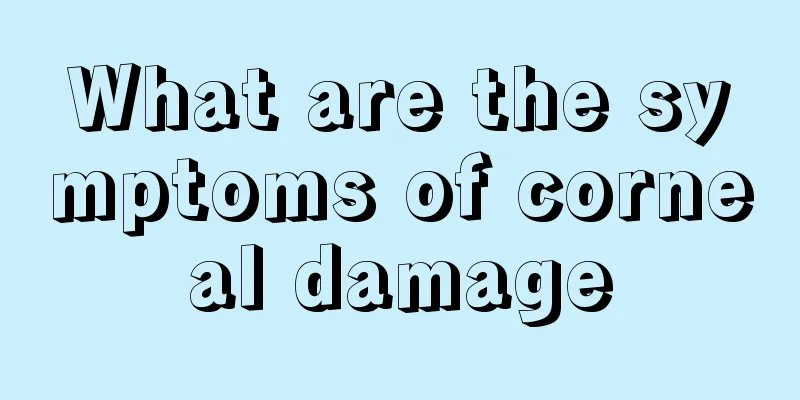What are the symptoms of corneal damage

|
I believe that many people often encounter the problem of corneal injury in their daily lives. Most of the corneal injuries are caused by accidental bumps or bruises. They are often accompanied by corneal pain, red and swollen eyes, prolonged tears, fear of light and wind, so you must slowly adjust your condition to prevent the condition from getting worse. Clinical manifestations 1) Corneal abrasion: The patient's vision in the injured eye is impaired because the sensory nerve endings of the injured eye's cornea are exposed. Immediately after the injury, the patient experiences severe pain, photophobia, foreign body sensation, eyelid spasm, and heavy tearing. Tears also flow in the contralateral healthy eye. The severity of symptoms is related to the extent of the injury. Examination under the slit lamp can reveal oblique, dull, band-like lesions of the corneal epithelium or clearly demarcated, flake-like areas without epithelial defects, with a flat and smooth anterior Descemet's membrane underneath. The pupil is reflexively constricted and the corneal margin is ciliary congested. To further examine the extent of epithelial edema and defects, one drop of 1% to 2% sodium fluorescein solution can be instilled into the conjunctival sac. Under cobalt blue light, the area of corneal epithelial edema or defects will appear bright green. The most common complication of corneal abrasion is infection. Because the corneal epithelium is an important protective barrier of the eye, corneal abrasion can cause local infiltration of the corneal stroma, and infection by pathogens carried by the wounding object can aggravate the symptoms. 2) Loss of deep corneal tissue: Symptoms of corneal abrasion such as pain, photophobia, foreign body sensation and tearing exist but are relatively mild. Examination under the slit lamp reveals edema, thickening and opacity of the corneal stroma, and wrinkles in the posterior Descemet's membrane, which may be localized. Corneal lamellar lacerations may sometimes occur, which may be accompanied by infection and ulcers. 3) Corneal contusion: The main symptoms are pain, photophobia, tearing, ciliary congestion and decreased vision. Mild corneal contusion causes local damage to corneal tissue, and linear, lattice-shaped, and disc-shaped opacities can be seen on the cornea; more severe contusion can cause damage to the corneal endothelial cells, weakening or even losing the water pumping function within the matrix, leading to increased corneal water content and lumpy or diffuse edema of the corneal matrix. 4) Interlaminar corneal laceration: Patients often experience pain, photophobia, tearing and decreased vision. Due to the edema or lift of the torn corneal flap, patients will have an obvious foreign body sensation. Under the slit lamp, the torn corneal flap can be seen flipped up and curled up, and the corneal flap and surrounding stroma are edematous. 5) Corneal perforation and rupture: Corneal rupture caused by strong external force often occurs near the corneal edge because the structure here is relatively weak. The patient has a clear history of eye trauma, and may experience transient pain during the injury and persistent pain after the injury. Due to full-thickness corneal laceration, aqueous humor flows out and the patient will feel a stream of hot water flowing out of the injured eye. The injured eye will experience symptoms such as photophobia, tearing, blepharospasm and decreased vision due to corneal damage. Most corneal wounds are located in the palpebral fissure, and the Seidel test can be used to determine whether the wound is closed. Larger lacerations or irregular wounds may cause the anterior chamber to become shallower due to the outflow of aqueous humor, and the pupil to become pear-shaped or displaced. The iris may often be seen incarcerated in the corneal wound. The iris corresponding to the corneal wound may have iris perforation, and severe contusion may also cause iris root detachment accompanied by anterior chamber hemorrhage. Deep corneal perforations can cause lens damage, which may cause rupture of the anterior lens capsule, opacity of the lens cortex or overflow into the anterior chamber, or rupture of the posterior lens capsule. Severe damage can cause the lens to subluxate or even completely dislocate into the vitreous cavity. Due to the high force of trauma, the lens is dislocated, and the vitreous body is often embedded in the anterior chamber, or even prolapsed together with the retina. Careful examination and identification should be carried out under the slit lamp. |
<<: What to do if cornea is burned
>>: How to treat liver and gallbladder obstruction
Recommend
The root of my ear and cheek hurt
The ear is an important part of the body. Many pe...
The dangers of twisting ears
I believe that many people have experienced being...
What details should be paid attention to when choosing wet wipes
Wet wipes have entered more and more people's...
How to treat advanced lung cancer
The patient, a 44-year-old female, was diagnosed ...
What causes excessive sweating in the upper body?
There is actually not a single reason for sweatin...
Tibetan medicine for gout
Gout is a relatively common disease with complex ...
What are sexually transmitted diseases
When it comes to sexually transmitted diseases, e...
The role and function of vitamin C
People often hear the word "vitamins" o...
Frequent twitching while sleeping
Sleep is very important to us. The quality of sle...
Physical changes after quitting smoking for one year
In contemporary society, more and more people are...
Bacterial vaginitis can actually cause these complications!
Bacterial vaginosis is one of the most common gyn...
Things to note when doing yoga to reduce waist and abdomen
As we all know, yoga has many benefits. It can in...
Is cervical cancer hereditary?
Will cervical cancer be inherited? Cervical cance...
Early symptoms of hemorrhoids
Hemorrhoids are the common name for hemorrhoids a...
Symptoms of excessive toxins in the body
Body toxins are harmful substances that accumulat...









